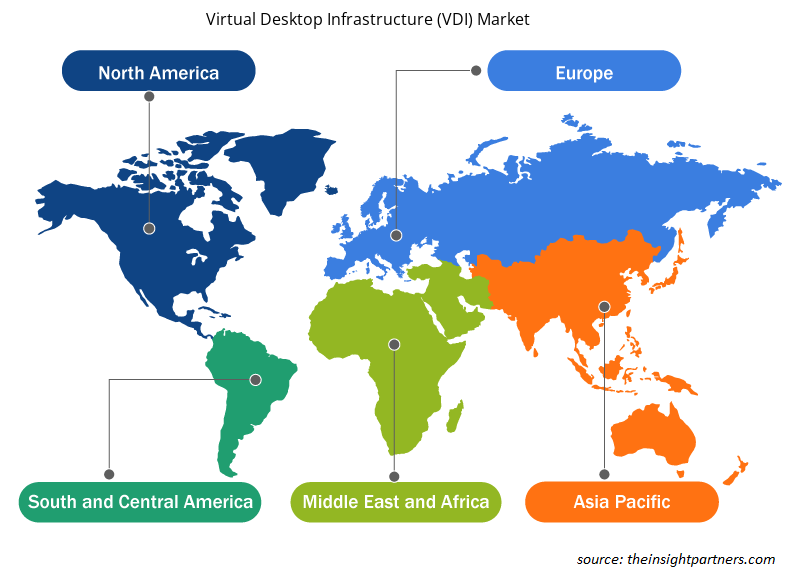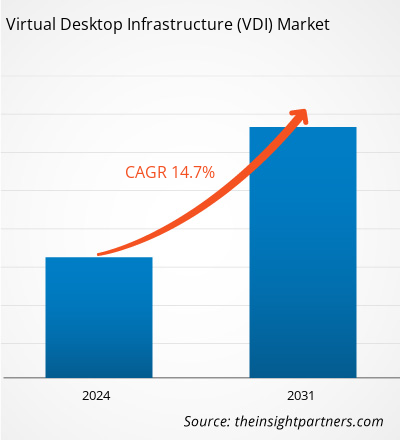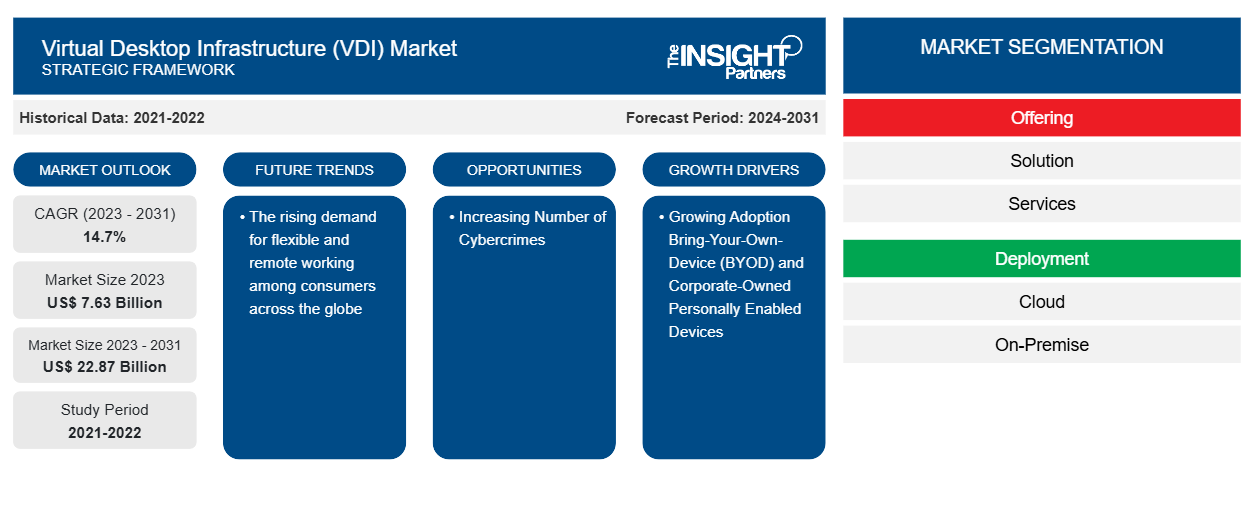Si prevede che la dimensione del mercato dell'infrastruttura desktop virtuale (VDI) raggiungerà i 22,87 miliardi di dollari entro il 2031, rispetto ai 7,63 miliardi di dollari del 2023. Si prevede che il mercato registrerà un CAGR del 14,7% nel 2023-2031. La crescente domanda di lavoro flessibile e da remoto tra i consumatori in tutto il mondo rimarrà probabilmente una tendenza chiave del mercato dell'infrastruttura desktop virtuale (VDI).
Analisi di mercato dell'infrastruttura desktop virtuale (VDI)
Il mercato dell'infrastruttura desktop virtuale (VDI) sta crescendo a un ritmo rapido a causa della crescente adozione di BYOD e dispositivi abilitati personalmente dalle aziende e delle crescenti preoccupazioni per la sicurezza tra i consumatori. Il mercato si sta espandendo costantemente, guidato dall'espansione delle PMI e dalle severe normative governative per le misure di sicurezza. Inoltre, il crescente numero di crimini informatici e l'integrazione di tecnologie avanzate come AI, cloud computing e IoT nell'infrastruttura desktop virtuale stanno offrendo opportunità redditizie per la crescita del mercato.
Panoramica del mercato dell'infrastruttura desktop virtuale (VDI)
Le soluzioni di infrastruttura desktop virtuale (VDI) sono spesso basate su un'architettura client/server con il sistema operativo e le applicazioni dell'organizzazione. Le soluzioni VDI sono in esecuzione su un server nel cloud o in un data center. In questa architettura, tutte le interazioni con gli utenti avvengono su un dispositivo locale scelto dall'utente. VDI è anche una componente importante dei luoghi di lavoro digitali, a causa della dipendenza dei moderni carichi di lavoro di desktop virtuali che si basano sulla tecnologia di infrastruttura desktop virtuale, che viene eseguita su macchine virtuali in locale o in data center cloud pubblici. Ciò aumenta l'uso di infrastruttura desktop virtuale tra le aziende per semplificare il lavoro dei dipendenti e sta alimentando il mercato.
Personalizza questo report in base alle tue esigenze
Riceverai la personalizzazione gratuita di qualsiasi report, comprese parti di questo report, o analisi a livello nazionale, pacchetto dati Excel, oltre a usufruire di grandi offerte e sconti per start-up e università
- Scopri le principali tendenze di mercato in questo rapporto.Questo campione GRATUITO includerà analisi di dati che spaziano dalle tendenze di mercato alle stime e alle previsioni.
Driver e opportunità del mercato dell'infrastruttura desktop virtuale (VDI)
La crescente adozione di Bring-Your-Own-Device (BYOD) e di dispositivi personali di proprietà aziendale sta guidando il mercato
L'espansione della forza lavoro mobile aumenta la domanda di infrastrutture desktop virtuali per migliorare la produttività delle aziende. L'infrastruttura desktop virtuale consente ai dipendenti di accedere alle immagini dei propri desktop virtuali tramite smartphone, laptop e dispositivi mobili. La crescente adozione di BYOD e dispositivi abilitati individualmente di proprietà aziendale sta spingendo la domanda per il mercato delle infrastrutture desktop virtuali nel settore IT e delle telecomunicazioni. Le aziende stanno lavorando sotto pressione per adottare tecnologie virtuali avanzate attribuite alla consumerizzazione dell'IT, alla mobilità e al BYOD. Ciò aumenta la loro attenzione sullo sviluppo di infrastrutture desktop virtuali avanzate per gestire la consumerizzazione e i costi dell'IT. Tuttavia, la virtualizzazione desktop sta diventando sempre più popolare grazie a una maggiore sicurezza, conformità e governance, che dovrebbero alimentare il mercato durante il periodo di previsione.BYOD and corporate-owned individually enabled devices is propelling the demand for the virtual desktop infrastructure market in the IT and telecom industry. Businesses are working under pressure to adopt advanced consumerization of IT, mobility, and BYOD. This increases their focus on developing advanced virtual desktop infrastructure to manage IT consumerization and costs. However, desktop virtualization is becoming increasingly popular due to enhanced security, compliance, and governance, which is expected to fuel the market during the forecast period.
Aumento del numero di crimini informatici: un’opportunità nel mercato delle infrastrutture desktop virtuali (VDI)Cybercrimes – An Opportunity in the Virtual Desktop Infrastructure (VDI) Market
I progressi nella tecnologia di virtualizzazione hanno fatto aumentare l'uso dell'infrastruttura desktop virtuale tra le aziende per dare priorità alla sicurezza e alla conformità contro violazioni dei dati e attacchi informatici. Il crescente numero di reati informatici in tutto il mondo sta creando opportunità sul mercato. Ad esempio, secondo il rapporto Digital Banking Fraud Trends in North America di BioCatch di dicembre 2023, i tassi di mobile banking sono cresciuti al 73% nel 2023. Ciò, a sua volta, ha causato un aumento sostanziale delle frodi eseguite tramite dispositivi mobili, passando dal 47% nel 2022 al 61% nel 2023. Ciò aumenta l'adozione dell'infrastruttura desktop virtuale tra gli utenti per ridurre i rischi e proteggere i propri dati e informazioni dagli attacchi informatici.
Analisi della segmentazione del rapporto di mercato dell'infrastruttura desktop virtuale (VDI)
I segmenti chiave che hanno contribuito alla derivazione dell'analisi di mercato dell'infrastruttura desktop virtuale (VDI) sono l'offerta, l'implementazione, le dimensioni aziendali e l'utente finale.
- In base all'offerta, il mercato dell'infrastruttura desktop virtuale (VDI) è suddiviso in soluzioni e servizi. Il segmento delle soluzioni ha detenuto una quota di mercato maggiore nel 2023.
- In termini di distribuzione, il mercato è categorizzato come cloud e on-premise. Il segmento cloud ha detenuto una quota di mercato maggiore nel 2023.
- Sulla base delle dimensioni aziendali, il mercato dell'infrastruttura desktop virtuale (VDI) è suddiviso in PMI e grandi imprese. Il segmento PMI ha detenuto una quota di mercato maggiore nel 2023.
- In termini di utente finale, il mercato dell'infrastruttura desktop virtuale (VDI) è segmentato in IT e telecomunicazioni, governo, sanità, BFSI, istruzione, vendita al dettaglio, produzione e altri utenti finali. Il segmento IT e telecomunicazioni ha detenuto una quota di mercato maggiore nel 2023.
Analisi della quota di mercato dell'infrastruttura desktop virtuale (VDI) per area geografica
L'ambito geografico del rapporto sul mercato dell'infrastruttura desktop virtuale (VDI) è suddiviso principalmente in cinque regioni: Nord America, Asia Pacifico, Europa, Medio Oriente e Africa e Sud America/Sud e Centro America.
In termini di fatturato, il Nord America ha rappresentato la quota di mercato più grande per l'infrastruttura desktop virtuale (VDI), a causa della crescente adozione della tecnologia cloud tra le aziende. La crescente domanda di infrastruttura desktop virtuale da parte dei settori IT e telecomunicazioni, gaming, elettronica di consumo e intrattenimento per migliorare il lavoro collaborativo potenziando l'efficienza operativa sta guidando il mercato. Inoltre, la preferenza dei dipendenti per il lavoro flessibile e da remoto sta incrementando il mercato dell'infrastruttura desktop virtuale (VDI) nel prossimo futuro.
Approfondimenti regionali sul mercato dell'infrastruttura desktop virtuale (VDI)
Le tendenze regionali e i fattori che influenzano il mercato Virtual Desktop Infrastructure (VDI) durante il periodo di previsione sono stati ampiamente spiegati dagli analisti di Insight Partners. Questa sezione discute anche i segmenti di mercato Virtual Desktop Infrastructure (VDI) e la geografia in Nord America, Europa, Asia Pacifico, Medio Oriente e Africa e Sud e Centro America.

- Ottieni i dati specifici regionali per il mercato Virtual Desktop Infrastructure (VDI)
Ambito del rapporto di mercato sull'infrastruttura desktop virtuale (VDI)
| Attributo del report | Dettagli |
|---|---|
| Dimensioni del mercato nel 2023 | 7,63 miliardi di dollari USA |
| Dimensioni del mercato entro il 2031 | 22,87 miliardi di dollari USA |
| CAGR globale (2023-2031) | 14,7% |
| Dati storici | 2021-2022 |
| Periodo di previsione | 2024-2031 |
| Segmenti coperti | Offrendo
|
| Regioni e Paesi coperti | America del Nord
|
| Leader di mercato e profili aziendali chiave |
|
Densità degli attori del mercato dell'infrastruttura desktop virtuale (VDI): comprendere il suo impatto sulle dinamiche aziendali
Il mercato Virtual Desktop Infrastructure (VDI) sta crescendo rapidamente, spinto dalla crescente domanda degli utenti finali dovuta a fattori quali l'evoluzione delle preferenze dei consumatori, i progressi tecnologici e una maggiore consapevolezza dei vantaggi del prodotto. Con l'aumento della domanda, le aziende stanno ampliando le loro offerte, innovando per soddisfare le esigenze dei consumatori e capitalizzando sulle tendenze emergenti, il che alimenta ulteriormente la crescita del mercato.
La densità degli operatori di mercato si riferisce alla distribuzione di aziende o società che operano in un particolare mercato o settore. Indica quanti concorrenti (operatori di mercato) sono presenti in un dato spazio di mercato in relazione alle sue dimensioni o al valore di mercato totale.
Le principali aziende che operano nel mercato delle infrastrutture desktop virtuali (VDI) sono:
- Amazon.com, Inc
- Cisco Systems, Inc.
- Società IBM
- Società Microsoft
- VMware, Inc.
- Fujitsu Limited
Disclaimer : le aziende elencate sopra non sono classificate secondo un ordine particolare.

- Ottieni una panoramica dei principali attori del mercato Virtual Desktop Infrastructure (VDI)
Notizie di mercato e sviluppi recenti dell'infrastruttura desktop virtuale (VDI)
Il mercato dell'infrastruttura desktop virtuale (VDI) viene valutato raccogliendo dati qualitativi e quantitativi dopo la ricerca primaria e secondaria, che include importanti pubblicazioni aziendali, dati associativi e database. Di seguito è riportato un elenco degli sviluppi nel mercato dell'infrastruttura desktop virtuale (VDI) e delle strategie:
- Ad agosto 2023, VMware, Inc. VMware ha annunciato moderne integrazioni AI nella piattaforma Anywhere Workspace che ottimizzano automaticamente l'esperienza dei dipendenti, guidano nuovi casi d'uso di gestione delle vulnerabilità e semplificano la gestione del ciclo di vita delle applicazioni. VMware Anywhere Workspace è l'unica piattaforma di lavoro ibrida che integra l'esperienza digitale dei dipendenti (DEX), l'infrastruttura e le app desktop virtuali (VDI e DaaS), la gestione unificata degli endpoint (UEM) e la sicurezza per abilitare uno spazio di lavoro fluido e sicuro su qualsiasi dispositivo o posizione. (Fonte: VMware, Inc., comunicato stampa, 2023)
- A settembre 2022, Amazon.com, Inc. ha annunciato Amazon WorkSpaces Core, un nuovo servizio di infrastruttura desktop virtuale (VDI) completamente gestito che combina la sicurezza, l'affidabilità globale e l'efficienza dei costi di AWS con le soluzioni di gestione VDI esistenti. (Fonte: Amazon.com, Inc., comunicato stampa, 2023)
Copertura e risultati del rapporto di mercato sull'infrastruttura desktop virtuale (VDI)
Il rapporto "Dimensioni e previsioni del mercato dell'infrastruttura desktop virtuale (VDI) (2021-2031)" fornisce un'analisi dettagliata del mercato che copre le seguenti aree:
- Dimensioni e previsioni del mercato a livello globale, regionale e nazionale per tutti i segmenti di mercato chiave coperti dall'ambito
- Dinamiche di mercato come fattori trainanti, vincoli e opportunità chiave
- Principali tendenze future
- Analisi dettagliata delle cinque forze PEST/Porter e SWOT
- Analisi di mercato globale e regionale che copre le principali tendenze di mercato, i principali attori, le normative e gli sviluppi recenti del mercato
- Analisi del panorama industriale e della concorrenza che copre la concentrazione del mercato, l'analisi della mappa di calore, i principali attori e gli sviluppi recenti
- Profili aziendali dettagliati
- Analisi storica (2 anni), anno base, previsione (7 anni) con CAGR
- Analisi PEST e SWOT
- Valore/volume delle dimensioni del mercato - Globale, Regionale, Nazionale
- Industria e panorama competitivo
- Set di dati Excel
Report recenti
Testimonianze
Motivo dell'acquisto
- Processo decisionale informato
- Comprensione delle dinamiche di mercato
- Analisi competitiva
- Analisi dei clienti
- Previsioni di mercato
- Mitigazione del rischio
- Pianificazione strategica
- Giustificazione degli investimenti
- Identificazione dei mercati emergenti
- Miglioramento delle strategie di marketing
- Aumento dell'efficienza operativa
- Allineamento alle tendenze normative























 Ottieni un campione gratuito per - Mercato delle infrastrutture desktop virtuali (VDI)
Ottieni un campione gratuito per - Mercato delle infrastrutture desktop virtuali (VDI)